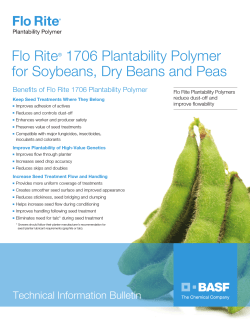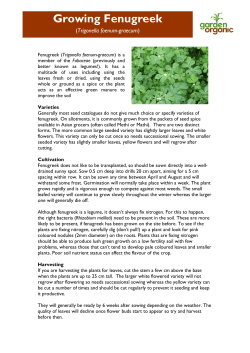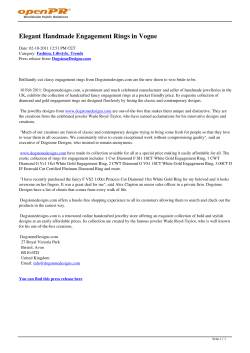
2013 South Dakota Crop Protection Guide Corn Seed Treatments
2013 South Dakota Crop Protection Guide Corn Seed Treatments Weeds: Mike Moechnig, Darrell L. Deneke, Leon J. Wrage, Jill Alms, Dave Vos, and Mark Rosenberg Insects: Adrianna Szczepaniec and Buyung Hadi Diseases: Kay Ruden “This document represents only a portion of the 2013 Corn Crop Protection Guide. The complete guide is available at iGrow.org. Information in this publicationis based on SDSU and other research and observations and provides a summary of label recommendations. It is not intended as a label replacement. Always verify information on current product labels prior to use of any pesticide. Users are responsible for following all label directions and precautions.” Published by iGrow, a service of SDSU Extension. For more information in the fields of agriculture, farming and rural living available in print, electronically, or on-line, visit iGrow.org. © 2013 South Dakota Board of Regents. All rights reserved. Published as an excerpt from the 2013 Soybeans Crop Protection Guide. South Dakota State University is an Affirmative Action/Equal Opportunity Employer and offers all benefits, services, education, and employment opportunities without regard for race, color, creed, religion, national origin, ancestry, citizenship, age, gender, sexual orientation, disability, or Vietnam Era Veteran status. 03-3000-20131/13 Managing Crop Diseases with Seed Treatments Seed treatment fungicides are used in various agricultural crops and are useful tools in promoting stand establishment and seedling vigor. Seed treatments may also help preserve yield potential and prevent quality losses in grain by preventing development of seed and soil-borne diseases. Seed treatments addressed in this guide are those consisting of fungicides or fungicides in combination with insecticides for use in managing disease-causing organisms (pathogens). The development of effective seed treatments can be noted as one of the most significant advancements in plant disease management. In general, fungicidal seed treatments are used for three primary reasons: (1) To control soil-borne fungal disease organisms such as those causing seed rots, damping-off, or seedling blights in many crops, as well as the agents of root rot complex, smuts, bunts, or downy mildews. (2) To control diseases caused by seed surface-borne fungal pathogens (e.g., covered smuts of barley and oats, bunt of wheat, safflower rust, and Ascochyta of legumes. (3) To manage diseases caused by seed-borne fungi, such as loose smut of cereals. Fungicide seed treatments are not effective against bacterial pathogens or in managing viral diseases. Most seed treatment products do not control all types of fungal pathogens. Disease Management Using Seed Treatments Disease management in agricultural crops requires a multi-faceted approach as part of an integrated pest management (IPM) program. Effective components of an integrated plant disease management program include the following: • Crop rotation, including rotation to non-host crops to reduce pathogen load. • Residue and volunteer management for reduction of residue-borne and overwintering diseases. • Use of high quality, disease-free seed to prevent the spread of seed-borne diseases and promote healthy stand establishment. Proper variety selection for host resistance and adaptation to the growing region. • • Proper plant health management. Healthy plants are more able to resist or tolerate the development of plant diseases. • Judicious use of plant protectant products such as herbicides, insecticides, and fungicides to reduce losses, promote healthy plants, and prevent quality losses in seed. Field history is a key component of the decision-making process for managing diseases with seed treatments. Keeping in mind the cropping sequence and the history of major disease or insect pests within the field can be important factors in seed treatment decisions. Proper identification of disease agents is also important. Agronomy or Plant Pathology Extension Field Specialists at the Regional Extension Centers or the Plant Disease Diagnostic Clinic at SDSU can assist producers in identifying plant health problems throughout the growing season. Effectiveness of control will vary with seed treatment product, rate, environmental conditions, and pests present. Seed treatments may provide some level of control for early season diseases as well as control seedling blights and seed or soil-borne diseases. Newly Opened Land – A Special Consideration Newly opened land, such as CRP being returned to crop production, may present a special consideration and most certainly will be a situation where seed treatments should be considered. For example, small grains planted into these areas can be at high risk for the development of diseases and insect pests. Diseases such as root and crown rots, as well as seedling blights, can often be more severe when certain crops are planted into these high-residue situations. Also, insect pressure on newly cultivated lands may differ from a typical cropping situation. South Dakota 2013 Crop Protection Guide – Corn 1 Classification of Fungicidal Seed Treatments Fungicidal seed treatments can be classified based on movement of the seed treatment product in relation to the seed. Fungicides used as protectants (contacts) are effective only on the seed surface, providing protection against seed surface-borne pathogens and providing some level of control of soil-borne pathogens. These products generally have a relatively short residual. Protectant fungicides such as captan, maneb, thiram, or fludioxonil help control most types of soil-borne pathogens, with the exception of the root rotting organisms. Systemic seed treatment fungicides are absorbed into the emerging seedling and inhibit or kill the fungus inside host plant tissues. Systemic fungicides used for seed treatment include the following: azoxystrobin, carboxin, mefenoxam, metalaxyl, thiabendazole, trifloxystrobin, and various triazole fungicides, including difenoconazole, ipconazole, tebuconazole, and triticonazole. Mefenoxam and metalaxyl are primarily used to target the water mold fungi Pythium and Phytophthora. Biological agents as seed treatments are also available and may provide some level of protectant activity. Not all fungicides are available as seed treatments for every crop, and not all fungicides have activity against the same range of organisms. Refer to the specific crop-pest combinations listed in the text for product-use recommendations. Always read and follow label directions. Proper Application and Use Precautions Fungicide seed treatment products vary in formulation type, packaging, and use requirements. Products may be dry or liquid and in concentrate or ready-to-use formulations. While many seed treatments may be applied on-farm, several products are limited to use only by commercial applicators using closed application systems. Caution should be used when handling or working with seed treatment products. Fungicide seed treatments can be highly poisonous and many are irritants, so proper handling precautions must be taken when handling seed treatment chemicals, and producers or applicators must strictly adhere to all label directions regarding safe handling, mixing, storage, and disposal. Using personal protection, including an approved chemical respirator, goggles, and pesticide resistant gloves, is recommended even if not specifically required by the fungicide label. Follow label rates, as over-application may result in unintentional damage to the seed, and under-application may reduce the effectiveness of products. Properly calibrate all application equipment to assure uniform coverage. Uniform coverage of the seed is critical to optimize effectiveness of the seed treatment. Several seed treatment methods are available, though not all are appropriate for every situation. Commercial application or application through dedicated seed treatment equipment will likely provide the most uniform coverage. Grain auger mounted treatment equipment is available, and may provide adequate coverage in an on-farm situation; however, an auger that has been used to treat seed may be unusable for moving grain intended for food or feed. Likewise, treated seed should not be allowed to contaminate equipment used to transport or store food or feed grains. Use caution when considering planter-applied (planter-box) seed treatments. Good disease control depends on uniform fungicide coverage of the seed, and this is more difficult to accomplish in planter-applied situations. Always read and follow label directions. Understand the product-specific guidelines for proper application: how and when to apply, feeding or grazing restrictions, as well as important safety precautions. Always dispose of pesticide containers properly. Seed Treatments and Legume Inoculants Seed treatments containing fungicides or fungicide/insecticide combinations may adversely affect microbial inoculants applied to legume seed, such as soybeans. Producers should carefully read and follow any label instructions and limitations for both the pesticide seed treatment and the inoculant. Liquid fungicides or fungicide/ insecticide combinations should not be directly mixed with liquid inoculants prior to application, and care should be taken to limit the time that inoculants and pesticide seed treatments are in direct contact. Do Not Use Treated Seed for Food or Feed!! Following are the seed treatments fungicides or fungicide/insecticide combinations currently labeled for use in South Dakota. The list is dynamic and prone to frequent modifications. Always check the list of products currently registered with the South Dakota Department of Agriculture for legality of use in the state. 2 www.iGrow.org Corn Seed Treatments Diseases Listed on Label Head Smut Seed & Seedling Rots Fusarium Root Diseases Seed Treatment Products Application Rate Special Notes Rhizoctonia Root Diseases abamectin + one of the following: azoxystrobin, fludioxonil, mefenoxam and thiamethoxam Avicta Complete Corn See product label For control of corn nematodes. abamectin + thiamethoxam Avicta Duo Corn See product label For control of corn nematodes. 0.153 fl oz/cwt (0.0025 mg ai/kernel) Use Dynasty only in combination with labeled rates of Maxim 4FS, Maxim XL and Apron XL products. Avicta Duo 250 Corn X X X X X X X X X X X X X X X azoxystrobin Dynasty Bacillus firmus I-1582 + clothianidin Poncho/VoTiVO 2.7 fl oz/80,000 seeds Bacillus subtilis GB03 Kodiak HB 4 oz/cwt captan Captan 400 1.25-2.375 fl oz/cwt Captan 400-C 1.25-2.375 fl oz/cwt carboxin Vitavax-34 2-4 oz/cwt carboxin + metalaxyl + imidacloprid Latitude 1.5 oz/42 lb carboxin + permethrin Kernel Guard Supreme 1.5 oz/42 lb carboxin + thiram Vitaflo 280 4.5 fl oz/cwt for control of seed & seedling rots, Fusarium and Rhizoctonia root diseases. For control of corn nematodes. For suppression of Fusarium and Pythium root diseases. Do not graze or feed livestock on treated areas for 6 weeks after planting. Do not graze or feed livestock on treated areas for 45 days. Do not graze or feed livestock on treated areas for 6 weeks after planting. Do not graze or feed livestock on treated areas for 6 weeks after planting. 8.5-11 fl oz/cwt for control of seed-borne head smut. X X X X fludioxonil Maxim 4FS 0.08-0.16 fl oz/cwt Forage may not be grazed until 30 days after planting. South Dakota 2013 Crop Protection Guide – Corn 3 Corn Seed Treatments Diseases Listed on Label Seed Treatment Products Special Notes Head Smut Seed & Seedling Rots Fusarium Root Diseases Rhizoctonia Root Diseases X X X X fludioxonil + mefenoxam Maxim XL 0.167-0.334 fl oz/cwt (0.009-0.018 mg ai/kernel) Corn forage may not be grazed until 30 days after planting. X X X X fludioxonil + mefenoxam + azoxystrobin + thiabendazole Maxim Quattro 0.46 fl oz/80,000 kernel count Forage may not be grazed until 30 days after planting. X X X fludioxonil + mefenoxam + azoxystrobin + thiamethoxam Cruiser Extreme See product label Forage may not be grazed until 30 days after planting. X X X ipconazole Acceleron DC-509 0.085 fl oz/cwt Vortex 0.044 fl oz/cwt mancozeb Dithane M45 2.7-5.4 oz/cwt Penncozeb 4FL 4.3-6.8 fl oz/cwt Penncozeb 75DF 2.9-5.8 oz/cwt Penncozeb 80WP 2.7-5.4 oz/cwt mancozeb + surfactant Dithane F-45 4.3-8.6 fl oz/cwt Manzate Flowable 4.3-8.6 fl oz/cwt Manzate Pro-Stick 2.7-5.4 oz/cwt X maneb Manex 4.3-8.6 fl oz/cwt X mefenoxam Apron XL X X Apron XL LS 4 Application Rate www.iGrow.org 0.0425-0.085 fl oz/cwt (0.0025-0.005 mg ai/kernel) For control of Pythium damping-off only. Corn Seed Treatments Diseases Listed on Label Head Smut Seed & Seedling Rots Fusarium Root Diseases Seed Treatment Products X X X Special Notes Rhizoctonia Root Diseases X X Application Rate X metalaxyl Acceleron DC-309 1.5 fl oz/cwt Acceleron DX-309 0.75 fl oz/cwt Allegiance Dry 1.5-2.0 oz/cwt Allegiance FL 0.75 fl oz/cwt Aquire 0.75 fl oz/cwt Belmont 2.7 FS 0.75 fl oz/cwt Dyna-Shield Metalaxyl 0.75 fl oz/cwt MetaStar ST 0.75 fl oz/cwt Sebring 2.65 ST 0.75 fl oz/cwt Sebring 318 FS 0.75 fl oz/cwt Sebring 480 FS 0.50 fl oz/cwt metalaxyl + imidacloprid Concur 1.5 oz/42 lb metconazole Metlock For control of Pythium damping-off only. For control of Pythium seedling diseases. 0.045-0.09 fl oz/cwt (for Rhizoctonia, Fusarium root diseases and seed & seedling rots). 0.18-0.52 fl oz/cwt (for head smut). X X X X X X pyraclostrobin Stamina X pyraclostrobin + triticonazole + metalaxyl 3 Stamina F HL tebuconazole Raxil 2.6F X Sativa 309 FS thiram Signet 480 FS X X X X trifloxystrobin Acceleron DX-709 0.4-0.8 fl oz/cwt 1.0 fl oz/cwt X X trifloxystrobin + metalaxyl Trilex 2000 For suppression of Rhizoctonia root rot disease. 0.075-0.1 fl oz/cwt for control of soilborne and seedborne Fusarium. 0.37-0.74 fl oz/cwt for control of soilborne and seedborne head smut. 1.5 fl oz/bu 0.32-0.64 fl oz/cwt Trilex Flowable X For suppression of Fusarium and Pythium seed and seedling diseases. 0.5 fl oz/cwt Do not plant any crop without trifloxystrobin tolerances until 30 days after planting. Do not plant any crop without trifloxystrobin tolerances until 30 days after planting. South Dakota 2013 Crop Protection Guide – Corn 5
© Copyright 2025










